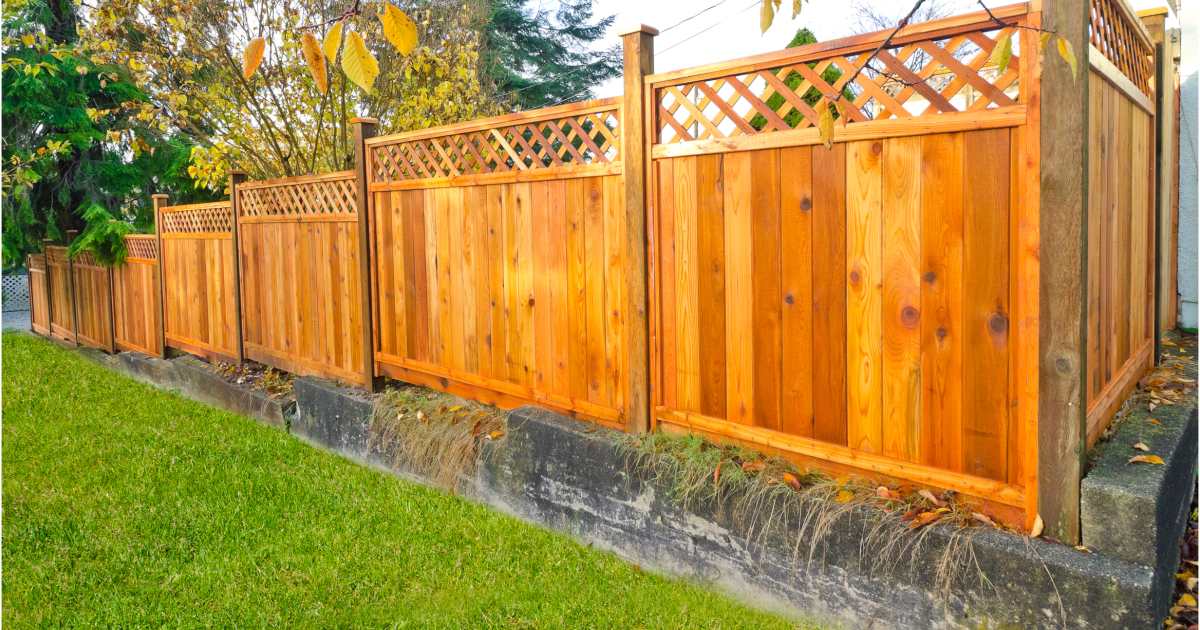All Categories
Featured
Not only does this shield your fencing from the components, however it also helps preserve the wood's all-natural look. Several home owners ask yourself: How usually should I paint or stain my wooden fence?
The answer relies on a number of factors, consisting of the type of timber, the environment in your area, and whether the fence is tarnished or painted. Let's damage down the vital considerations to aid you determine the perfect schedule for painting or tarnishing your wooden fencing.
Sun Exposure: Fences in areas with extreme sunshine are a lot more prone to drying, fading, and cracking. This suggests you may require to paint or restain your fence every 2 to 3 years to shield it from UV damage. Rainfall and Humidity: Surround regions with hefty rain or high moisture can absorb moisture, triggering the wood to swell, warp, or rot. Staining can offer a protective obstacle, yet you may need to restain every 2 years approximately to maintain the timber secured and protected. Snow and Freezing Temperatures: If your fencing is in a location with cold wintertimes, cold and thawing cycles can trigger the paint or tarnish to peel off and fracture. Relying on your climate, you might require to repaint or restain every 3 to 5 years. 2. Kind of Wood. The sort of wood used for your fencing likewise impacts just how typically you must use paint or tarnish. Various woods respond differently to wetness and sunshine, so the upkeep timetable can differ.
![]()
Cedar and Redwood: These naturally resilient woods resist rot and bug damage, however they can fade with time because of sun exposure. If you intend to keep the timber's abundant color, you may require to tarnish or seal it every 2 to 3 years. Pine and Fir: Softwoods like ache and fir are a lot more prone to weathering, and they have a tendency to absorb wetness quicker. Consequently, you might require to stain or repaint these timbers extra often, possibly every 1 to 2 years, to safeguard versus water damages and staining. Pressure-Treated Wood: Pressure-treated wood is made to resist rot and bug damage. It still requires sealing to protect against wetness absorption. Relying on direct exposure, a good tarnish or sealer might require to be reapplied every 2 to 3 years. 3. Stain vs. repaint. Whether you paint or discolor your fencing can additionally affect exactly how often it requires maintenance.
Paint: Repaint provides a thicker, much more nontransparent layer of protection, blocking UV rays and moisture. Paint can chip, peel, and fracture over time, particularly in locations with extreme climate conditions. Generally, repainted fences need to be repainted every 3 to 5 years, yet this can differ depending on direct exposure to the components. Discolor: Discolor penetrates the wood, supplying a much more all-natural appearance while supplying some security against the sun and moisture. Stain has a tendency to deteriorate quicker than paint, so you may need to restain your fencing extra frequently-- usually every 2 to 3 years. The advantage of tarnish is that it doesn't peel off, making it much easier to maintain over time. 4. Indications That It's Time to Restain or paint. Even if you do not have a set schedule, there are several indicators that show it's time to paint or restain your fencing:
Fading or Staining: If your fence has actually shed its abundant shade and appears faded or gray, it's time to add a fresh coat of tarnish or paint. Peeling or Splitting: If you notice peeling off paint or splitting tarnish, your fencing is no more completely protected, and it's time to repair or begin over. Water Absorption: An easy examination can assist you determine if your fence is still sufficiently sealed. Sprinkle some water on the surface; if it grains up, the paint or tarnish is still doing its task. If the water saturates into the wood, it's time to reapply. 5. Appropriate Prep Work and Application. When it's time to paint or stain, correct preparation is necessary for long-lasting results. Tidy the fence thoroughly to eliminate dirt, mold, or mildew, and fix any broken areas prior to applying paint or tarnish. For the very best outcomes, choose a dry, moderate day for application-- prevent painting in severe warmth or moisture, as it can discolor or cause the paint to completely dry too quickly or unevenly.
![]()
Conclusion. As a whole, you ought to prepare to repaint or stain your wooden fencing every 2 to 3 years, though the exact timetable will depend on your environment, the kind of timber, and whether you have actually painted or stained the fence. Routine upkeep not only aids keep your fence looking excellent but also expands its life expectancy by safeguarding the timber from dampness, UV rays, and various other environmental variables. By staying on top of this task, you'll ensure your fence continues to be both practical and gorgeous for years ahead.
The answer relies on a number of factors, consisting of the type of timber, the environment in your area, and whether the fence is tarnished or painted. Let's damage down the vital considerations to aid you determine the perfect schedule for painting or tarnishing your wooden fencing.
- Environment and Climate Conditions. The environment in your location plays a significant function in how typically your fence needs maintenance. Surround locations with extreme climate condition, such as high moisture, hefty rain, or intense sun exposure, will need even more regular painting or staining than those in pleasant climates.
Sun Exposure: Fences in areas with extreme sunshine are a lot more prone to drying, fading, and cracking. This suggests you may require to paint or restain your fence every 2 to 3 years to shield it from UV damage. Rainfall and Humidity: Surround regions with hefty rain or high moisture can absorb moisture, triggering the wood to swell, warp, or rot. Staining can offer a protective obstacle, yet you may need to restain every 2 years approximately to maintain the timber secured and protected. Snow and Freezing Temperatures: If your fencing is in a location with cold wintertimes, cold and thawing cycles can trigger the paint or tarnish to peel off and fracture. Relying on your climate, you might require to repaint or restain every 3 to 5 years. 2. Kind of Wood. The sort of wood used for your fencing likewise impacts just how typically you must use paint or tarnish. Various woods respond differently to wetness and sunshine, so the upkeep timetable can differ.

Cedar and Redwood: These naturally resilient woods resist rot and bug damage, however they can fade with time because of sun exposure. If you intend to keep the timber's abundant color, you may require to tarnish or seal it every 2 to 3 years. Pine and Fir: Softwoods like ache and fir are a lot more prone to weathering, and they have a tendency to absorb wetness quicker. Consequently, you might require to stain or repaint these timbers extra often, possibly every 1 to 2 years, to safeguard versus water damages and staining. Pressure-Treated Wood: Pressure-treated wood is made to resist rot and bug damage. It still requires sealing to protect against wetness absorption. Relying on direct exposure, a good tarnish or sealer might require to be reapplied every 2 to 3 years. 3. Stain vs. repaint. Whether you paint or discolor your fencing can additionally affect exactly how often it requires maintenance.
Paint: Repaint provides a thicker, much more nontransparent layer of protection, blocking UV rays and moisture. Paint can chip, peel, and fracture over time, particularly in locations with extreme climate conditions. Generally, repainted fences need to be repainted every 3 to 5 years, yet this can differ depending on direct exposure to the components. Discolor: Discolor penetrates the wood, supplying a much more all-natural appearance while supplying some security against the sun and moisture. Stain has a tendency to deteriorate quicker than paint, so you may need to restain your fencing extra frequently-- usually every 2 to 3 years. The advantage of tarnish is that it doesn't peel off, making it much easier to maintain over time. 4. Indications That It's Time to Restain or paint. Even if you do not have a set schedule, there are several indicators that show it's time to paint or restain your fencing:
Fading or Staining: If your fence has actually shed its abundant shade and appears faded or gray, it's time to add a fresh coat of tarnish or paint. Peeling or Splitting: If you notice peeling off paint or splitting tarnish, your fencing is no more completely protected, and it's time to repair or begin over. Water Absorption: An easy examination can assist you determine if your fence is still sufficiently sealed. Sprinkle some water on the surface; if it grains up, the paint or tarnish is still doing its task. If the water saturates into the wood, it's time to reapply. 5. Appropriate Prep Work and Application. When it's time to paint or stain, correct preparation is necessary for long-lasting results. Tidy the fence thoroughly to eliminate dirt, mold, or mildew, and fix any broken areas prior to applying paint or tarnish. For the very best outcomes, choose a dry, moderate day for application-- prevent painting in severe warmth or moisture, as it can discolor or cause the paint to completely dry too quickly or unevenly.

Conclusion. As a whole, you ought to prepare to repaint or stain your wooden fencing every 2 to 3 years, though the exact timetable will depend on your environment, the kind of timber, and whether you have actually painted or stained the fence. Routine upkeep not only aids keep your fence looking excellent but also expands its life expectancy by safeguarding the timber from dampness, UV rays, and various other environmental variables. By staying on top of this task, you'll ensure your fence continues to be both practical and gorgeous for years ahead.
Latest Posts
The Restroom Upgrade Every Detroit Home Is Worthy Of
Published Apr 19, 25
1 min read
Affordable Car Repair Services at Montclare Auto Repair - Don’t Wait, Act Now!
Published Apr 19, 25
2 min read
Unlock Exclusive Discounts with WyHy's Love My Lending institution Rewards
Published Apr 19, 25
1 min read
More
Latest Posts
The Restroom Upgrade Every Detroit Home Is Worthy Of
Published Apr 19, 25
1 min read
Affordable Car Repair Services at Montclare Auto Repair - Don’t Wait, Act Now!
Published Apr 19, 25
2 min read
Unlock Exclusive Discounts with WyHy's Love My Lending institution Rewards
Published Apr 19, 25
1 min read